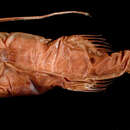en
names in breadcrumbs


Gigantactis meadi is a species of fish in the whipnose angler (Gigantactinidae) family, first described in 1981 by Erik Bertelsen, Theodore Wells Pietsch III and Robert J. Lavenberg.[2][3] The genus name, Gigantactis, derives from the Greek, gigas (gigantic ) and aktis (ray), describing the fish by its long dorsal-fin spine which serves as a lure.[1]
It has six dorsal soft rays and six anal soft rays.[1]
It is found in the bottom ocean waters in seas off Argentina, Australia, Brazil, Chile, the Falkland Islands, French Southern Territories, Heard Island and McDonald Islands, New Zealand, Norfolk Island, Saint Helena, Tristan da Cunha, South Africa, South Georgia, the South Sandwich Islands and Uruguay, at depths of 1,213 metres to 2,000 metres.[4] In Australia it is found in waters south of Tasmania.[2]
{{cite journal}}: CS1 maint: multiple names: authors list (link)  Holotype (MCZ 52572) site: south-west Indian Ocean
Holotype (MCZ 52572) site: south-west Indian Ocean Gigantactis meadi is a species of fish in the whipnose angler (Gigantactinidae) family, first described in 1981 by Erik Bertelsen, Theodore Wells Pietsch III and Robert J. Lavenberg. The genus name, Gigantactis, derives from the Greek, gigas (gigantic ) and aktis (ray), describing the fish by its long dorsal-fin spine which serves as a lure.
It has six dorsal soft rays and six anal soft rays.
It is found in the bottom ocean waters in seas off Argentina, Australia, Brazil, Chile, the Falkland Islands, French Southern Territories, Heard Island and McDonald Islands, New Zealand, Norfolk Island, Saint Helena, Tristan da Cunha, South Africa, South Georgia, the South Sandwich Islands and Uruguay, at depths of 1,213 metres to 2,000 metres. In Australia it is found in waters south of Tasmania.